In a pesticide-free garden, many types of beneficial insects help keep insect populations in balance. The great golden digger wasp is a specialized hunter of insects in the Orthoptera order, which includes katydids, crickets and grasshoppers. This beautiful bright orange and gold wasp is a solitary, predatory wasp. Females build individual nests in the ground, hunt prey in the garden or landscape, then cache the prey in the nest, which becomes the food source for their developing offspring. Great golden digger wasp larvae spin a silken cocoon before winter, then overwinter in this prepupal stage in their nest below ground.
You don’t have to worry about being stung by these large wasps; like solitary bees, solitary wasps do not defend their nests and do not behave aggressively. (I would not recommend trying to handle them, however.) By providing areas of bare, unplanted soil and some of their favorite forage plants, you will likely see these wasps visiting and possibly calling your garden home.
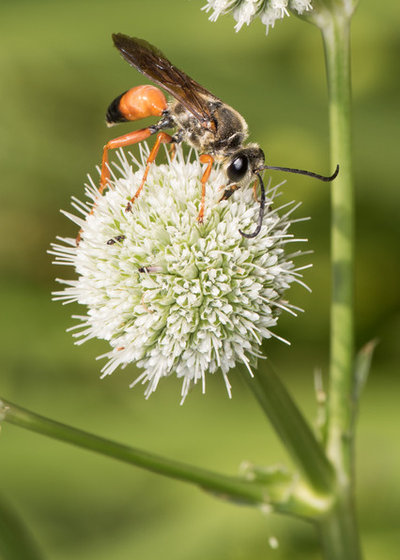
Holm Design & Consulting LLC
Family: Sphecidae (thread-waisted wasps)
Latin name: Sphex ichneumoneusCommon name: Great golden digger wasp
Distribution: Found in the Western Hemisphere from southern Canada southward to central South America
Habitat: Woodland edges, gardens, meadows, prairies, old fields and farms; nests often occur in well-drained, sandy or gravelly soil
Shown: An adult visiting rattlesnake master (
Eryngium yuccifolium)
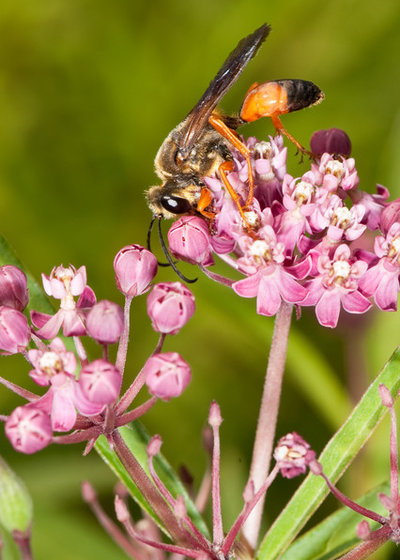
Holm Design & Consulting LLC
When to look for them: In the northern United States, late June or early July is often when some of the first sightings of adult wasps occur (earlier in the spring farther south); nest construction and provisioning begin in July; following these initial tasks, adults can be observed visiting flowers in mid to late July through September
Shown: An adult visiting swamp milkweed (
Asclepias incarnata)
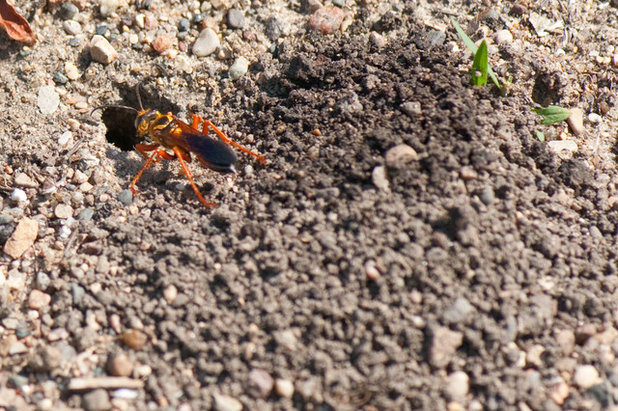
Holm Design & Consulting LLC
How They HelpGreat golden digger wasps are predatory, solitary wasps. Females hunt for a variety of insect prey belonging to the insect order Orthoptera. Insects in this order include grasshoppers, katydids and crickets.
Besides hunting these herbivorous prey, adults also visit a variety of flowering plants for nectar and can be quite effective pollinators in some cases. These beautiful wasps often demonstrate a preference for plants with white flowers. Nectar from flowering plants provides energy for the adults, especially the females that are excavating nests and hunting for prey.
Shown: A female excavating her nest in open, bare sandy soil
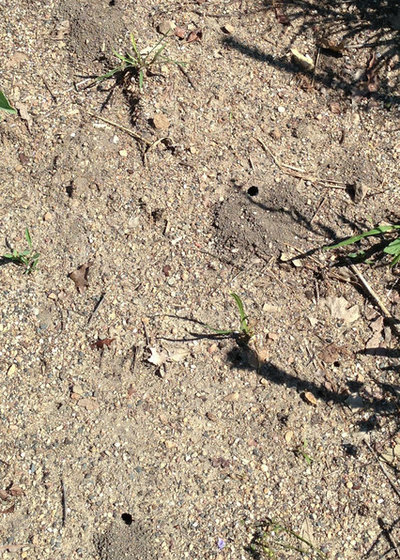
Holm Design & Consulting LLC
How to Spot Great Golden Digger WaspsAdults: These large, bright orange and black wasps are hard to miss, although they do move quickly. Golden hairs cover their head and thorax. Great golden digger wasps range from about ½ inch (13 millimeters) to over 1 inch (25 millimeters) in length. These wasps, along with other wasps in the Sphecidae family, have a very narrow section (thread waist) connecting their abdomen to their thorax. Their legs are orange; their abdomen is orange with a black band near the bottom of the abdomen or with a black-tipped abdomen.
Babies (larvae): Larvae develop inside the burrow in the ground and feed on the Orthoptera prey cached by their mother.
Shown: An aggregation of great golden digger wasps nests in open, bare soil; as the soil is excavated, it is usually deposited or flung by the female in one direction away from the hole
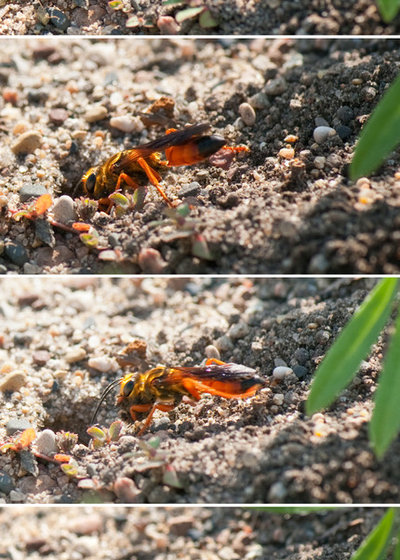
Holm Design & Consulting LLC
How to Lure ThemProvide a nesting place. Besides maintaining a pesticide-free garden and continuous succession of flowering plants, you will need to provide a place in your garden with bare soil where great golden digger wasps can excavate their nests in the ground. Females prefer bare, open sites with sandy, sandy-loam or gravelly soils.
Nest excavation typically begins in early July. Females loosen and then move the soil from the burrow, holding it between their head and forelegs. Once outside the burrow, the female wasps back up several inches and then fling the soil ball under them with their forelegs. The soil is typically deposited in one direction, giving the tumulus, or soil deposited around the nest entrance, a lopsided appearance.
Nests can occur in large aggregations where bare areas of soil exist. The nesting site can be used from one year to the next by the following generation.
Maintain a pesticide-free yard. Do not use pesticides, especially insecticides, in the garden, particularly on flowering plants.
Shown: A progression of images showing how the female excavates soil from the nest
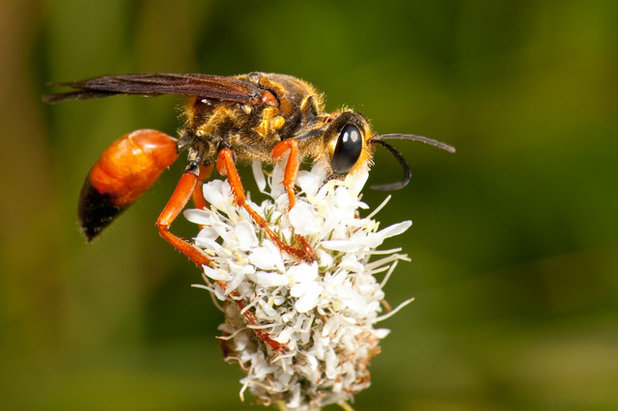
Holm Design & Consulting LLC
Offer forage plants for adults. After emerging from their natal nest, females excavate a new nest in the ground, in many cases in the same area as their natal nest. Once some nest provisioning has occurred, the adults can be observed visiting flowers for nectar in late July through early September.
Sample plant list for adults:- Summer: Swamp milkweed (Asclepias incarnata), whorled milkweed (Asclepias verticillata), pale Indian plantain (Arnoglossum atriplicifolium), white prairie clover (Dalea candida), Culver’s root (Veronicastrum virginicum), spotted beebalm (Monarda punctata), Virginia mountain mint (Pycnanthemum virginianum), rattlesnake master (Eryngium yuccifolium)
- Late summer and fall: Goldenrod (Solidago spp.)
Browse native plants for your region
Shown: An adult visiting white prairie clover

Holm Design & Consulting LLC
Life cycle. After emerging from their natal nest, females excavate a new nest to rear their own offspring.
Like ground-nesting solitary bees, they will excavate a main burrow tunnel with branching lateral tunnels that terminate in a brood cell.
Each brood cell is provisioned with multiple insects, typically katydids, when available. The female wasp hunts for the katydids in the landscape and stings them between their head and thorax to immobilize (paralyze) the large prey; clutching the paralyzed prey underneath her, she then carries it back to the nest.
Upon returning to the nest, she drops the prey near the nest entrance, reopens the closed nest and goes inside to check on the nest. She emerges head first, grabs the prey with her mandibles and then drags the prey into the nest (see photo sequence above).
Once a nest is provisioned with prey and eggs have been laid, the females construct an entirely new nest. Over her lifespan, each female will create anywhere from two to 11 nests before perishing.
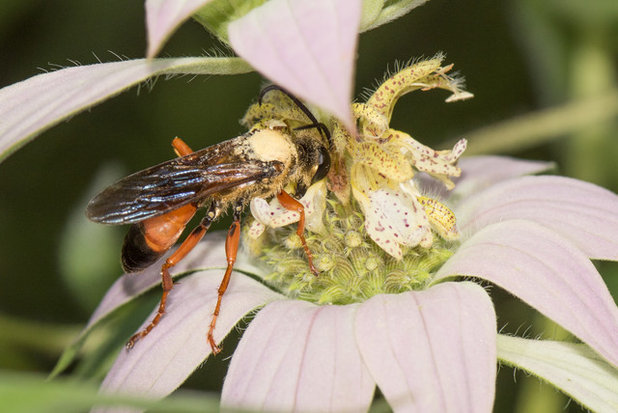
Holm Design & Consulting LLC
The female wasp lays an egg on the last paralyzed prey cached in a brood cell. She then backfills the tunnel to the brood cell with soil.
The larvae hatch in the following days and consume the cached prey for the next seven to 14 days. When the food provisions are entirely consumed, each larva spins a cocoon and overwinters in the cocoon in a prepupal state. It then finishes development the following spring, pupating and emerging as an adult in July.
Shown: An adult visiting spotted beebalm
Region by region: What to do in your garden this month





